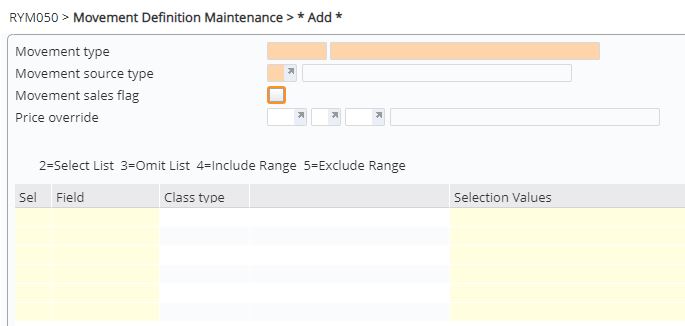Movement definitions are used to specify which transactions are to be used in the calculation of a Title’s Royalties. Transactions can be classified as sales (therefore royalties are calculated), or stock movements which are excluded from the royalties calculation. Based on the Movement type codes the system determines which transactions are to be transferred from the Title’s transaction file to the royalties file for calculating the amount for Royalties payment.
Movement types can be linked. A field in the Movement type definition indicates the linkage. For example if the Royalties rate varies depending on whether or not the sales are local sales or export sales, but the calculation is based on the total quantity sold (export + local), two Movement types are created. These two Movement types are then linked via an entry made on the Movement types.
Movement types can also be created to include or exclude customer groups. This is done by recording the Customer Classification Codes and flagging them for inclusion or exclusion in the Royalties calculation.
Control-files TMSRY/RY-MVTGP and TMSRY/RY-MVTLK consolidate/group together different movement types. The consolidated movement is entered in RY-MVTGP and the link to the consolidated movement is in RY-MVTLK. This allows the consolidated movement to be entered in the contracts and the linked movements to be setup in the movement definition. The statement should show the individual movements. You would also see the individual movements in the LTD inquiries. It allows the consolidated movement be applied to the contract once as long as the linked movements follow the same royalty rate and steps. If the consolidated movement rate etc is changed, it would be implied that the same would apply to the linked movements.
When multiple Movement types are applicable on a Contract, the sequence number given to the Movement type, when listing them on the Contract, determines the sequence of checking for matching conditions in the sales information. If a transaction does not meet the criteria as defined for the first Movement type, the system refers to the next Movement type, and so on. The Royalties statement prints details according to the Movement types.
Add a new movement type definition
- In the menu, expand Publishing Modules > Rights & Permissions > Maintenance and double-click RY Royalty Movement Definition. RYM050 Movement Definition Maintenance panel appears. List of existing movement definitions are displayed.
- Click Add. RYM050 Movement Definition Maintenance appears in add mode.
| Field | Description |
| Movement type |
This is a 6 character code to identify the movement type. The role of movement type is to allow different royalty rate charged based on works and rights type and it also determines which transactions are to be transferred from the Title’s transaction file to the Royalties file for calculating the royalty payment amount. When determining the Movement types, consider the sequence of the details on the Royalties Statement. |
| Movement source type |
These are defined in control file TMSRY/RY-MMF. Y = Manual. Use adjustment entry program to manually enter in transactions. Manual entries are never cleared. N = Internal sales. I = External sales interface/GDM transactions C = CAL transactions R = Subrights exploits, movement type for collections contracts |
| Movement sales flag |
This indicates whether the transactions transferred to Royalties are to be classified as sales or as stock movements. Y = classify as a sale and use in calculations. N = not a sale (no calculations) but to be included in the Royalty Movement of Sales. This only works out quantities to be displayed. Although Stock movements are not used to calculate royalties, these details can be shown on the Royalties Statement. This field in not applicable for CAL movement type (Movement source type = ‘C’ for CAL). |
| Price override |
The Price Code is used for Royalty calculations. All customers are assigned a default Pricing Code which determines the transaction price. If the transaction price is to be used when calculating the Royalty value, leave the field blank. If for example New Zealand sales are to have Royalties calculated at the Australian RRP price, the code for Australian RRP must be entered here. This field in not applicable for CAL movement type (Movement source type = ‘C’ for CAL). |
| Pay thru % | This is only applicable for CAL movement type (movement source type = ‘C’ for CAL). It specifies the percentage of any incoming CAL payment to be paid to the author/payee. |
- Enter the above information.
- Select and enter all the required selection fields and their values for the movement type as required.
Fields available for selection are dependent on the Movement source type.
-
- Sales region selection only applies to internal sales (Movement source type = ‘N’).
- The selection fields are not applicable for CAL movement types.
- For subright movement type only specific selection fields are applicable. Territory (TERT) field is available for subrights source type. This is to allow different royalty rates by territory for collection contracts. Different royalty rates can be setup for different territories as required.
| Note | If the movement type has *IMS against the field for selection options 2=list & 3=omit list than that field can be overridden at contract level. This is to enable capture of a list of customers or sales regions for a contract with a specific movement type. |
- Click OK to save the movement type.


